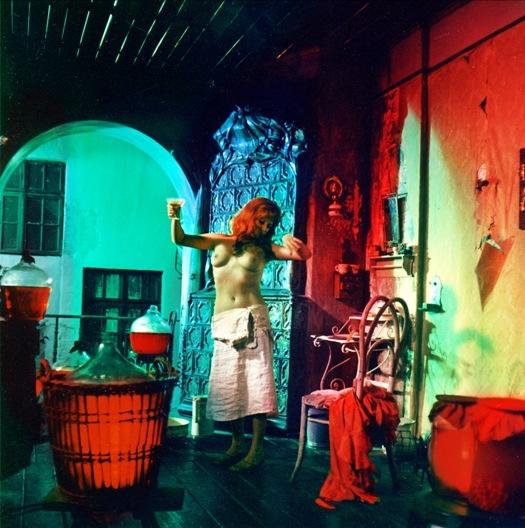Philip Roth once perversely suggested that Eastern European novelists whose work was banned under Communism were the lucky ones. They didn’t have to scour their navels for material; it was all there, dumped in their laps. In the second half of the 1980s, I devoured a lot of their fiction. If the novel came from the other side of the Iron Curtain, I’d buy. My policy was indiscriminate. It didn’t seem to matter if the author had been born too early for Communism. One of them was by Bruno Schulz, the Polish Jew who was shot by a Gestapo officer in 1942. The volume contained two shortish pieces of fiction: The Street of Crocodiles and Sanatorium under the Sign of the Hourglass. I distinctly remember starting one of them and quietly giving up halfway down page three. You really have to commit to surrealism.
The guilt is now somewhat assuaged. In 1973 the Polish director Wojciech J. Has released a film version of The Hourglass Sanatorium, as he titled it, and promptly won the Special Jury Prize in Cannes. It is shown tonight at the Barbican as the opening film in a Directorspective season of his work. This month five films are being screened in all, covering the period from 1958 to 1973. They in turn form part of the Barbican’s contribution to Polska! Year, a celebration of Polish culture lasting till next May. There is work from the artist Robert Kusmirowski, and Teatr ZAR (whose trilogy of plays closes tomorrow night). To celebrate the Has season, the Brothers Quay return to Schulz. Their stop-motion short from 1986 based on The Street of Crocodiles is cited by Terry Gilliam among others as one of the greatest animations ever made. They are now creating a new work inspired by the films of Wojciech Has.
The Hourglass Sanatorium feels like it couldn’t have been made any other year. Or indeed in any other place
There is a lot to be inspired by. You know you’re not in Kansas any more from the dazzling opening sequence of The Hourglass Sanatorium, set in a train carriage full of zombified humans of indeterminate age and era. The protagonist Jozef (played by Jan Nowicki) alights at the snowy gates of a run-down building in the country whose grand cobwebbed corridors seem all but deserted. Then he looks out of a window and sees himself arriving up the stairs. Time, it seems, is a stuck record.
A nurse shows him into a room where revealed beneath a shroud is the blanched figure of his father. This is why he has come. But is his father dead? Is anyone dead here in the sanatorium where, it is explained to Jozef, “There are things that can’t entirely happen... They just try to happen.” Jozef is drawn into what looks less like the life of the hospital than memories randomly summoned from his childhood. Here among teeming village streets and foggy gardens, Jozef encounters his jolly father, his mysteriously depressed mother, and a kittenish girl whom he evidently once spent hours contently ogling through a window pane. And throughout these disjointed recollections, a blind train conductor reappears like an omen from myth, emanating a terrible intent.
Has’s is a world liberated from the obligation to explain itself. Or as Jozef says to his father, “Everything is muddled up. One needs such patience to find the right meaning in this tangle.” Wise words. The Hourglass Sanatorium has the picaresque linearity of a tone poem – one critic greeted it as "the cinematographical equivalent of all Mahler’s symphonies put together”. As with all surrealist ventures, the pathway in is to surrender to its insistent self-belief. It helps that Has’s designs are mesmerisingly particular.
The tone darkens and the playfulness recedes as Jozef is lured towards a denouement that has its own terrifying logic. Having conjured up a vision of prelapsarian Poland before the war (Has was born in 1925, and died in 2000) when Jews and Christians cohabited in peace, there is a harrowing sequence in which Jewish inhabitants race out of town like rats from the sinking ship. This is Has’s allusion to the forces of history which devoured Schulz.
For all its retrospection, The Hourglass Sanatorium feels like it couldn’t have been made any other year. Or indeed in any other place. Unlike western directors with half an eye on the box office, Has had the advantage – as Roth might see it – of not having to answer to a marketplace. The film, like Has’s three-hour Napoleonic-era epic fable The Saragossa Manuscript (1965), went on to have a cultish influence on cinephiles across the globe. It’s possible they thrilled to it while in some form of narcotically induced altered state.
Whatever, it is difficult to believe that the gothic fairytales of Gilliam or Tim Burton could have happened without the phantasmagorical toybox provided for them by Has’s canon of work. Here it is crowded with lifesize men dressed as exotic birds, with waxwork figures from history, with surreally dancing Jews and a bosomy array of fleshy females. What is striking above all about his work – unlike that of his contemporary Andrzej Wajda – is its apolitical flavour. Has made films about psychology, not society. You would have to dig exceptionally deep to find anything that the Polish censors could have objected to. Apart, perhaps, from his flouting of all forms of regulation.















Add comment